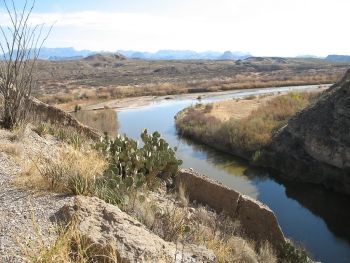
Publisher:
Bonnie King
CONTACT:
Newsroom@Salem-news.com
Advertising:
Adsales@Salem-news.com

~Truth~
~Justice~
~Peace~
TJP
Dec-05-2010 22:16

 TweetFollow @OregonNews
TweetFollow @OregonNews
Time to Reconsider Rio Grande Management?
Kent Patterson for Salem-News.comThe 2002 crisis may have come and gone, but the issues shaping the future of the Rio Grande...
 The Rio Grande exiting Santa Elena canyon. Courtesy: houstonfreeways.com |
(LAS CRUCES, N.M.) - If there is anything the US and Mexico has in common, it is the Rio Grande/Rio Bravo. A meandering ribbon that marks a huge chunk of the boundary between the two neighbors, the river provides millions of people with drinking, irrigation and recreational waters.
From its Colorado headwaters to the Gulf of Mexico, the Rio Grande is habitat for a plethora of animal and plant species, including migratory birds arriving from far to the north for winter refuge.
A purveyor of life in an arid environment spanning two nations, the Rio Grande ecosystem is an especially fragile one in a time of climate change.
Yet the river’s current order of importance in the bilateral relationship between the US and Mexico is far down the list of mutual priorities, upstaged by the so-called narco war, immigration, oil politics and issues of national security. That’s the assessment of a Mexican doctoral student who’s spent the fall semester in residence at the Department of Geography of New Mexico State University (NMSU).
“The basin of the Rio Grande is not on the agenda. They are discussing other things.” said Luzma Fabiola Nava, in an interview with Frontera NorteSur conducted on the NMSU campus.
“We are talking about the environment, a very basic resource. Control of and access to water is strategic to states all over the world.”
As part of her field work, Nava is visiting different sections of the Rio Grande to get an appreciation of an ancient ecosystem challenged by myriad forces on both sides of the border.
A graduate student at Quebec City’s Laval University, Nava said two basic agreements govern the US and Mexico’s division of the river’s waters. Consummated in 1906 during the presidency of Teddy Roosevelt, the first accord commits the US to delivering 60,000-acre feet of water for irrigation purposes to the Juarez Valley neighboring El Paso, Texas, every year.
Reached in 1944, the second agreement requires Mexico to release annually 350,000 acre-feet of water to Texas’ Lower Rio Grande Valley, while far to the west the US must ensure the transfer of Colorado River water to Mexico.
Importantly, a 1938 water compact involving the US states of Colorado, New Mexico and Texas has a bearing on the river’s flow, according to Nava.
As an interdisciplinary student of both politics and geography, Nava is writing her dissertation on bilateral, sustainable management of the Rio Grande. She has spent seven years living in Canada and studying boundary and other water policy issues affecting the member nations of the North American Free Trade Agreement.
In contrast to US and Canadian co-management of the Great Lakes, which arose from negotiations between more or less equal partners, US-Mexico agreements over the Rio Grande were brokered as part of relationship in which the interests of a more powerful nation held sway.
The disequilibrium, Nava contended, is evident in Mexico’s waving future claims to portions of the Rio Grande's water under the 1906 agreement. The 1944 arrangement, she added, was negotiated during a time of war when Washington’s national security interests drove policy. The two deals, Nava stressed, are now long outdated.
“We are sharing the water like we were in 1944,” she said, adding that booming populations up and down the watershed now compete for the river’s waters. Compounding the situation, Nava said, are pollution concerns and climate change challenges, including the possibility that precipitation will be much more limited in the future. Should the US/Mexico Rio Grande agreements be updated? “Absolutely,” Nava affirmed without hesitation.
The Mexican scholar, however, discounted any immediate move to negotiate new agreements. Short of a comprehensive overhaul in the bilateral relationship connected to the Rio Grande, Nava urged greater cooperation between Mexico and the US, as well as better conservation practices.
For the water policy researcher, positive developments include efforts by New Mexico’s Elephant Butte Irrigation District and others to look at capturing and using storm water.
According to Nava, crucial differences in river management distinguish the US from Mexico. North of the border, a variety of different federal, state, local and even tribal agencies perform different functions in Rio Grande governance, while in Mexico prime responsibility for the river rests with the federal government’s National Water Commission. Water quality standards also differ, Nava said, citing as an example divergent US and Mexican standards for fecal coliform bacteria.
Although a segmental approach to river management prevails- exemplified by large metro areas such as Albuquerque and El Paso coming up with plans for using their own part of the Rio Grande- a different conceptual framework which views the river as one large ecosystem needs to come into play, Nava argued.
Nava is far from the first to advocate for a paradigmatic shift in managing and preserving the Rio Grande. For example, appeals for broader river-wide management surfaced during 2002, when drought and water shortages prompted protests by farmers in Texas and the Mexican state of Tamaulipas.
As a result of the conflict, the US and Mexico signed Minute 308, a measure that gave immediate relief to Texas growers and laid the basis for at least some longer term planning. The agreement also committed Mexico, The US and the North American Development Bank to spend $210 million in irrigation system improvements.
The 2002 crisis may have come and gone, but the issues shaping the future of the Rio Grande and the use of its waters will not go away and remain to be addressed in a more urgent and holistic way, Nava insisted. “The basin is our common heritage, and we are all invited to take care of it,” she said.
Frontera NorteSur (FNS): on-line, U.S.-Mexico border news
Center for Latin American and Border Studies New Mexico
State University Las Cruces, New Mexico
Articles for December 4, 2010 | Articles for December 5, 2010 | Articles for December 6, 2010


googlec507860f6901db00.html
Salem-News.com:

Quick Links
DINING
Willamette UniversityGoudy Commons Cafe
Dine on the Queen
Willamette Queen Sternwheeler
MUST SEE SALEM
Oregon Capitol ToursCapitol History Gateway
Willamette River Ride
Willamette Queen Sternwheeler
Historic Home Tours:
Deepwood Museum
The Bush House
Gaiety Hollow Garden
AUCTIONS - APPRAISALS
Auction Masters & AppraisalsCONSTRUCTION SERVICES
Roofing and ContractingSheridan, Ore.
ONLINE SHOPPING
Special Occasion DressesAdvertise with Salem-News
Contact:AdSales@Salem-News.com
Terms of Service | Privacy Policy


All comments and messages are approved by people and self promotional links or unacceptable comments are denied.
Koyie June 2, 2011 8:55 am (Pacific time)
With the bases loaded you struck us out with that anwesr!
[Return to Top]©2025 Salem-News.com. All opinions expressed in this article are those of the author and do not necessarily reflect those of Salem-News.com.